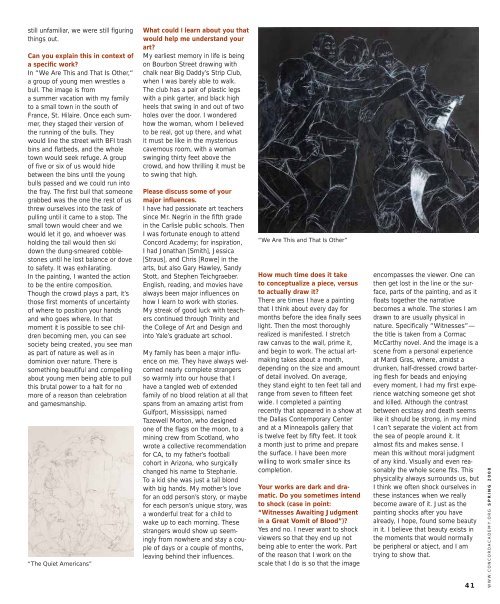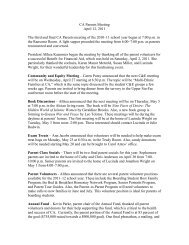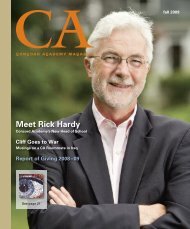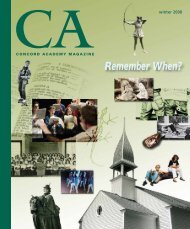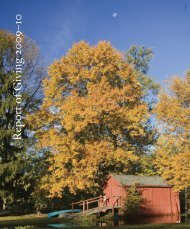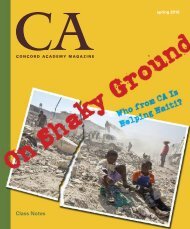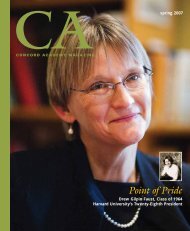WWW.CONCORDACADEMY.ORG
The Pull of Politics - Concord Academy
The Pull of Politics - Concord Academy
- No tags were found...
You also want an ePaper? Increase the reach of your titles
YUMPU automatically turns print PDFs into web optimized ePapers that Google loves.
still unfamiliar, we were still figuringthings out.Can you explain this in context ofa specific work?In “We Are This and That Is Other,“a group of young men wrestles abull. The image is froma summer vacation with my familyto a small town in the south ofFrance, St. Hilaire. Once each summer,they staged their version ofthe running of the bulls. Theywould line the street with BFI trashbins and flatbeds, and the wholetown would seek refuge. A groupof five or six of us would hidebetween the bins until the youngbulls passed and we could run intothe fray. The first bull that someonegrabbed was the one the rest of usthrew ourselves into the task ofpulling until it came to a stop. Thesmall town would cheer and wewould let it go, and whoever washolding the tail would then skidown the dung-smeared cobblestonesuntil he lost balance or doveto safety. It was exhilarating.In the painting, I wanted the actionto be the entire composition.Though the crowd plays a part, it’sthose first moments of uncertaintyof where to position your handsand who goes where. In thatmoment it is possible to see childrenbecoming men, you can seesociety being created, you see manas part of nature as well as indominion over nature. There issomething beautiful and compellingabout young men being able to pullthis brutal power to a halt for nomore of a reason than celebrationand gamesmanship.“The Quiet Americans”What could I learn about you thatwould help me understand yourart?My earliest memory in life is beingon Bourbon Street drawing withchalk near Big Daddy’s Strip Club,when I was barely able to walk.The club has a pair of plastic legswith a pink garter, and black highheels that swing in and out of twoholes over the door. I wonderedhow the woman, whom I believedto be real, got up there, and whatit must be like in the mysteriouscavernous room, with a womanswinging thirty feet above thecrowd, and how thrilling it must beto swing that high.Please discuss some of yourmajor influences.I have had passionate art teacherssince Mr. Negrin in the fifth gradein the Carlisle public schools. ThenI was fortunate enough to attendConcord Academy; for inspiration,I had Jonathan [Smith], Jessica[Straus], and Chris [Rowe] in thearts, but also Gary Hawley, SandyStott, and Stephen Teichgraeber.English, reading, and movies havealways been major influences onhow I learn to work with stories.My streak of good luck with teacherscontinued through Trinity andthe College of Art and Design andinto Yale’s graduate art school.My family has been a major influenceon me. They have always welcomednearly complete strangersso warmly into our house that Ihave a tangled web of extendedfamily of no blood relation at all thatspans from an amazing artist fromGulfport, Mississippi, namedTazewell Morton, who designedone of the flags on the moon, to amining crew from Scotland, whowrote a collective recommendationfor CA, to my father’s footballcohort in Arizona, who surgicallychanged his name to Stephanie.To a kid she was just a tall blondwith big hands. My mother’s lovefor an odd person’s story, or maybefor each person’s unique story, wasa wonderful treat for a child towake up to each morning. Thesestrangers would show up seeminglyfrom nowhere and stay a coupleof days or a couple of months,leaving behind their influences.“We Are This and That Is Other”How much time does it taketo conceptualize a piece, versusto actually draw it?There are times I have a paintingthat I think about every day formonths before the idea finally seeslight. Then the most thoroughlyrealized is manifested. I stretchraw canvas to the wall, prime it,and begin to work. The actual artmakingtakes about a month,depending on the size and amountof detail involved. On average,they stand eight to ten feet tall andrange from seven to fifteen feetwide. I completed a paintingrecently that appeared in a show atthe Dallas Contemporary Centerand at a Minneapolis gallery thatis twelve feet by fifty feet. It tooka month just to prime and preparethe surface. I have been morewilling to work smaller since itscompletion.Your works are dark and dramatic.Do you sometimes intendto shock (case in point:“Witnesses Awaiting Judgmentin a Great Vomit of Blood”)?Yes and no. I never want to shockviewers so that they end up notbeing able to enter the work. Partof the reason that I work on thescale that I do is so that the imageencompasses the viewer. One canthen get lost in the line or the surface,parts of the painting, and as itfloats together the narrativebecomes a whole. The stories I amdrawn to are usually physical innature. Specifically “Witnesses”—the title is taken from a CormacMcCarthy novel. And the image is ascene from a personal experienceat Mardi Gras, where, amidst adrunken, half-dressed crowd barteringflesh for beads and enjoyingevery moment, I had my first experiencewatching someone get shotand killed. Although the contrastbetween ecstasy and death seemslike it should be strong, in my mindI can’t separate the violent act fromthe sea of people around it. Italmost fits and makes sense. Imean this without moral judgmentof any kind. Visually and even reasonablythe whole scene fits. Thisphysicality always surrounds us, butI think we often shock ourselves inthese instances when we reallybecome aware of it. Just as thepainting shocks after you havealready, I hope, found some beautyin it. I believe that beauty exists inthe moments that would normallybe peripheral or abject, and I amtrying to show that.41<strong>WWW</strong>.<strong>CONCORDACADEMY</strong>.<strong>ORG</strong> SPRING 2008


